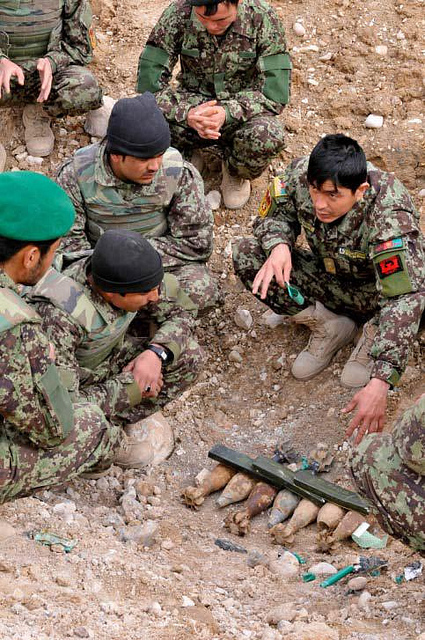As Nad ‘Ali looks to a brighter future, Tristan Kelly reports from the former Taliban stronghold.
 |
| Troops from B Company, 2nd Battalion The Royal Gurkha Rifles, stop to chat with some locals from Shin Kalay [Picture: Crown Copyright/MOD 2011] Source: Ministry of Defence, UK Click to enlarge |
With a reduction in violence of 86 per cent compared to 2010, the people who live in Nad ‘Ali district, an area once renowned for being a hotbed of the Taliban insurgency, are enjoying unprecedented levels of security.
And now, Afghan President Hamid Karzai has announced that the area, which is to the west of Lashkar Gah in Helmand province and within the British area of operations, will be among the second tranche of areas across the country to begin formal transfer to Afghan security control.
However, today’s relative security has been hard fought and some years in the making. British and other ISAF forces first entered the region in 2006.
Work soon began to disrupt and dislodge the Taliban from the region and in December 2008 a major operation — named SOND CHARA — was launched by British, Danish, Estonian and Afghan forces to clear insurgents from the district centre.
With two patrol bases quickly established, the operation was hailed a success and allowed ISAF and Afghan forces to move out from pockets of security to reassure the local population and offer a platform for stabilisation.
This foothold was expanded over time and culminated in Operation MOSHTARAK in February 2010. Meaning ‘together’ in Dari, Op MOSHTARAK was the largest counter-insurgency operation launched by ISAF forces since entering Afghanistan in 2001.
It involved some 15,000 ISAF troops from the UK, the US, Denmark, Estonia and Canada, as well as large numbers of Afghan troops.
The word ‘moshtarak’ underlined the key feature of the operation — the unprecedented and successful involvement of Afghan forces, including members of the Afghan National Army, Afghan National Police, Afghan Border Police and Afghan National Civil Order Police.
Speaking on the eve of the operation, Brigadier James Cowan, the then Commander of Task Force Helmand, said:
“I can think of no better name to describe this venture. For we are in this together: we have planned it together, we will fight it together, we will see it through together.”
Another key feature of the operational plan was ’seeing it through’ and the Provincial Reconstruction Team and Afghan government departments were involved from the very beginning in bringing governance to the region as soon as the insurgents had been driven out:
“We’ve got a government in a box, ready to roll in,” said US General Stanley McChrystal, ISAF commander at the time.
Jumping ahead 18 months and progress in Nad ‘Ali has been stark, with the reduction in violence taking some by surprise. This is particularly true in the southern half of the district, around the district centre.
Speaking at Patrol Base Chili in southern Nad ‘Ali, towards the end of his tour in September 2011, Major Jamie Murray, Officer Commanding B Company, 2nd Battalion The Royal Gurkha Rifles (2 RGR), whose area of operations covered approximately 25,000 of Nad ‘Ali’s population of 75,000–100,000, tells me just how quiet this tour has been:
“The summer fighting season has been very much suppressed and the conditions are set for an informal transition,” he said, adding that significant events, such as IED finds and contacts with the Taliban, were down 40 per cent on the previous HERRICK.
And the Taliban, according to the Major, were becoming ‘desperate’, and with that the quality of the enemy had reduced. He cited a recent incident where a suicide bomber had self-detonated in a field a long way from his target in the district centre as a key example.
 |
| The Nad ‘Ali and Lashkar Gah districts of Helmand province [Picture: via MOD] Source: Ministry of Defence, UK Click to enlarge |
Major Murray adds that the focus of this tour has been much more on interaction with local Afghans and showing them the benefits of Afghan government control. He also says that there has been a dramatic shift in the attitude of local Afghans since 2 RGR’s previous tour in 2009:
“We have conducted 75 shuras so far and each one is convivial,” Major Murray said.
“The locals are willing to provide us with information not just about security but about their lives in general — a year ago that shura would have been entirely about security and things to do with life and death.
“Now Afghan locals are telling us where bad things are happening, where IEDs are being laid. We now have well over 25,000 counter insurgents in this area, and that is the local people who are countering the insurgency.”
The next day I join a routine joint 2 RGR and Afghan National Civil Order Police patrol into the nearby village of Shin Kalay, whose streets and recently restored mosque are buzzing with activity.

 von
von 
